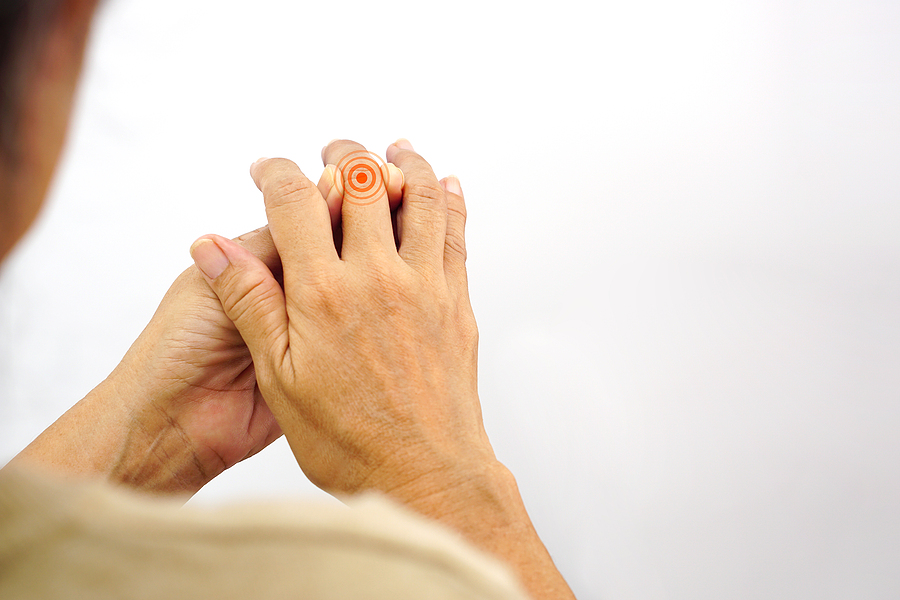Trigger finger, also known as tenosynovitis or stenosing tenovaginitis, is a hand disorder that affects the tendons that allow the thumb and fingers to flex. This condition is characterized by the sudden release or locking of one finger during extension (extending) or flexion (bending) [Ferrara]. Additional symptoms include pain, stiffness, and reduced mobility in the thumb and fingers.
 Trigger finger develops when a structure called the A1 pulley becomes inflamed and constricts the flexor tendon it is attached to, making it harder for the tendon to move freely. The compression (squeezing) of the tendon causes the locking or sudden release of the affected finger during movement. Pinching of the tendon can gradually lead to the formation of a nodule (lump) that may cause a popping or catching sensation. If the condition progresses, the affected finger may lock in a bent position. Some individuals with trigger finger may also have to use the opposite hand to straighten the thumb or finger manually. In severe cases, the finger can't be straightened without intervention from a health provider, such as a Physical Therapist.
Trigger finger develops when a structure called the A1 pulley becomes inflamed and constricts the flexor tendon it is attached to, making it harder for the tendon to move freely. The compression (squeezing) of the tendon causes the locking or sudden release of the affected finger during movement. Pinching of the tendon can gradually lead to the formation of a nodule (lump) that may cause a popping or catching sensation. If the condition progresses, the affected finger may lock in a bent position. Some individuals with trigger finger may also have to use the opposite hand to straighten the thumb or finger manually. In severe cases, the finger can't be straightened without intervention from a health provider, such as a Physical Therapist.
Causes of Trigger Finger
The underlying cause of trigger finger is unclear, but several factors increase the risk of developing this disorder. These include:
- Forceful hand movements, hand overuse, and repetitive blunt trauma
- Certain medical conditions (e.g., rheumatoid arthritis, diabetes, carpal tunnel syndrome)
- Age and genetics (more common in older individuals and rare in children)
Symptoms
The symptoms associated with trigger finger typically develop gradually without a clear cause or injury. However, this type of hand issue may arise following periods of repetitive actions, particularly grasping and pinching activities.
Specific symptoms that may develop include:
- Pain while straightening or bending the finger
- The formation of a tender nodule (lump) at the base of the thumb or finger on the inside of the hand
- A locking, catching, or popping sensation during thumb or finger movement
Locking and stiffness tend to worsen following periods of inactivity, such as after waking up in the morning. In mild to moderate cases, these symptoms often improve throughout the day with gentle hand movements. For some people, trigger finger resolves on its own with rest, but others may require treatment for chronic trigger finger that causes frustrating symptoms.
Treatment
Depending on to the severity of the injury, the following treatments are typically recommended for trigger finger:
- Hand splints
- Non-steroidal anti-inflammatory drugs (NSAIDs)
- Corticosteroid injections
- Physical Therapy
- Percutaneous or open surgery
Chronic, moderate, and severe cases of trigger finger often warrant rehabilitative interventions that include hand splints and Physical Therapy programs that involve mobilization, as well as stretching and strength-training exercises. In addition to these approaches, there are two types of Physical Therapy techniques that are frequently used to treat trigger finger: external shock wave therapy (ESWT) and ultrasound therapy (UST).
ESWT is a non-invasive approach that involves the administration of high-energy acoustic waves that promote the healing and repair of damaged tissue. Research shows that ESWT helps restore function in the hand and quality of life by reducing pain and trigger severity. The mechanism of action appears to be the stimulation of processes that generate new blood vessels, stem cells, and growth factors at the injury site. UST is another form of non-invasive treatment that entails the application of sound waves to damaged tissue. The sound waves are effective in reducing pain and preventing the recurrence of trigger finger symptoms by boosting blood flow, improving circulation, and promoting tissue healing.
A Physical Therapist may combine these types of treatments with additional approaches, such as therapeutic exercises, extension splints, and mobilization techniques. If you suspect that your hand problems may be due to trigger finger, the expert Physical Therapists at Baker Valley Physical Therapy in Baker County can discuss effective treatment options. Call our office today to speak with one of our health professionals.
References
1. Ferrara PE, Codazza S, Maccauro G., et al. Physical therapies for the conservative treatment of the trigger finger: A narrative review. Orthop Rev (Pavia). 2020;12(Suppl 1):8680.
2. Huisstede BM, Hoogvliet P, Coert JH, Fridén J. Multidisciplinary consensus guideline for managing trigger finger: results from the European HANDGUIDE study. Phys Ther. 2014;94:1421-1433.
3. Farnebo S, Chang J. Practical management of tendon disorders in the hand. Plast Reconstr Surg. 2013;132:841e-853e
4. Ryzewicz M, Wolf JM. Trigger digits: Principles, management, and complications. J Hand Surg Am. 2006;31:135-146.
5. Vahdatpour B, Momeni F, Tahmasebi A, Taheri P. The effect of extracorporeal shock wave therapy in the treatment of patients with trigger finger. J Sports Med. 2020;11:85-91.
6. Notarnicola A, Moretti B. The biological effects of extracorporeal shock wave therapy (eswt) on tendon tissue. Muscles Ligaments Tendons J. 2012;2(1):33-37.